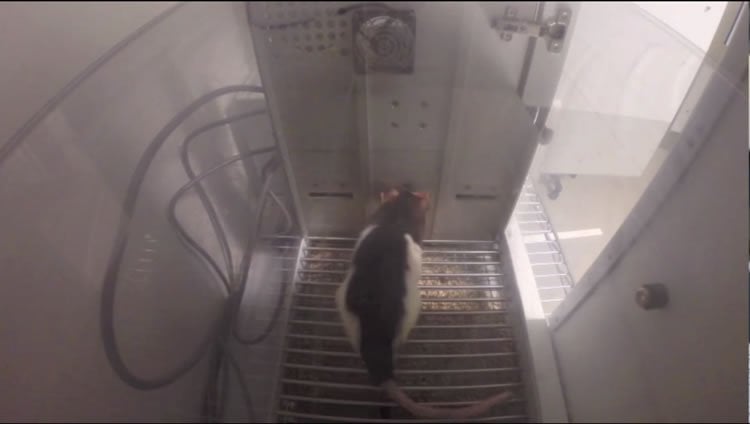In research published today in the Journal of Neuroscience, scientists at UBC discovered rats behaved like problem gamblers when sound and light cues were added to a “rat casino” model. What’s more, the researchers were able to correct the behaviour by blocking the action of a specific dopamine receptor, laying the groundwork for possible treatment of gambling addiction in humans.
The rats, who gambled for sugary treats, normally learn how to avoid the risky options. But that all changed when the scientists added flashing lights and sounds.
“It seemed, at the time, like a stupid thing to do, because it didn’t seem like adding lights and sound would have much of an impact. But when we ran the study, the effect was enormous,” said Catharine Winstanley, associate professor in the Department of Psychology and the Djavad Mowafaghian Centre for Brain Health. “Anyone who’s ever designed a casino game or played a gambling game will tell you that of course sound and light cues keep you more engaged, but now we can show it scientifically.”
When the scientists gave the rats a drug that blocked the action of a specific dopamine receptor that has been linked to addiction, the rats no longer acted like problem gamblers.

But the dopamine blockers had minimal effect on rats who gambled without the flashing lights and sound cues.
“This brain receptor is also really important to drug addiction, so our findings help support the idea that risky behaviour across different vices might have a common biological cause,” said lead author Michael Barrus, a PhD candidate in the UBC Department of Psychology.
Scientists at the University of British Columbia have found that adding lights and sounds to gambling games increases addictive behaviour — even in rats. Their work with a “rat casino” is providing insight into how gambling addiction develops, and how it might one day be treated.
“I often feel that scientific models are decades behind the casinos,” added Winstanley. “I don’t think it’s an accident that casinos are filled with lights and noise.”
Source: Heather Amos – University of British Columbia
Image Source: The image is adapted from the UBC video video
Video Source: The video is available at the UBC Public Affairs YouTube page
Original Research: Abstract for “Dopamine D3 Receptors Modulate the Ability of Win-Paired Cues to Increase Risky Choice in a Rat Gambling Task” by Michael M. Barrus and Catharine A. Winstanley in Journal of Neuroscience. Published online January 20 2016 doi:10.1523/JNEUROSCI.2225-15.2016
Abstract
Dopamine D3 Receptors Modulate the Ability of Win-Paired Cues to Increase Risky Choice in a Rat Gambling Task
Similar to other addiction disorders, the cues inherent in many gambling procedures are thought to play an important role in mediating their addictive nature. Animal models of gambling-related behavior, while capturing dimensions of economic decision making, have yet to address the impact that these salient cues may have in promoting maladaptive choice. Here, we determined whether adding win-associated audiovisual cues to a rat gambling task (rGT) would influence decision making. Thirty-two male Long–Evans rats were tested on either the cued or uncued rGT. In these tasks, animals chose between four options associated with different magnitudes and frequencies of reward and punishing time-out periods. As in the Iowa Gambling Task, favoring options associated with smaller per-trial rewards but smaller losses and avoiding the tempting “high-risk, high-reward” decks maximized profits. Although the reinforcement contingencies were identical in both task versions, rats’ choice of the disadvantageous risky options was significantly greater on the cued task. Furthermore, a D3 receptor agonist increased choice of the disadvantageous options, whereas a D3 antagonist had the opposite effects, only on the cued task. These findings are consistent with the reported role of D3 receptors in mediating the facilitatory effects of cues in addiction. Collectively, these results indicate that the cued rGT is a valuable model with which to study the mechanism by which salient cues can invigorate maladaptive decision making, an important and understudied component of both gambling and substance use disorders.
SIGNIFICANCE STATEMENT We used a rodent analog of the Iowa Gambling Task to determine whether the addition of audiovisual cues would affect choice preferences. Adding reward-concurrent cues significantly increased risky choice. This is the first clear demonstration that reward-paired cues can bias cost/benefit decision making against a subject’s best interests in a manner concordant with elevated addiction susceptibility. Choice on the cued task was uniquely sensitive to modulation by D3 receptor ligands, yet these drugs did not alter decision making on the uncued task. The relatively unprecedented sensitivity of choice on the cued task to D3-receptor-mediated neurotransmission data suggest that similar neurobiological processes underlie the ability of cues to both bias animals toward risky options and facilitate drug addiction.
“Dopamine D3 Receptors Modulate the Ability of Win-Paired Cues to Increase Risky Choice in a Rat Gambling Task” by Michael M. Barrus and Catharine A. Winstanley in Journal of Neuroscience. Published online January 20 2016 doi:10.1523/JNEUROSCI.2225-15.2016







